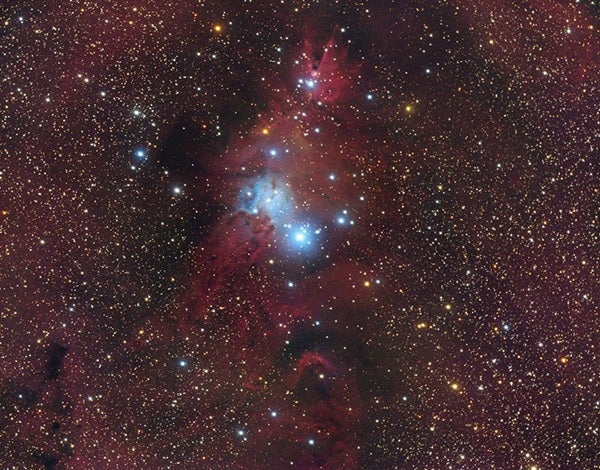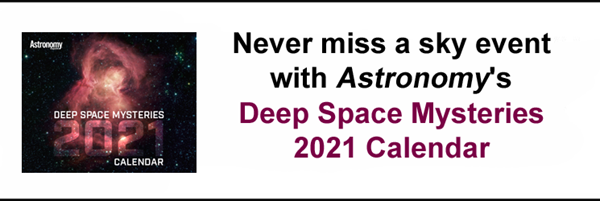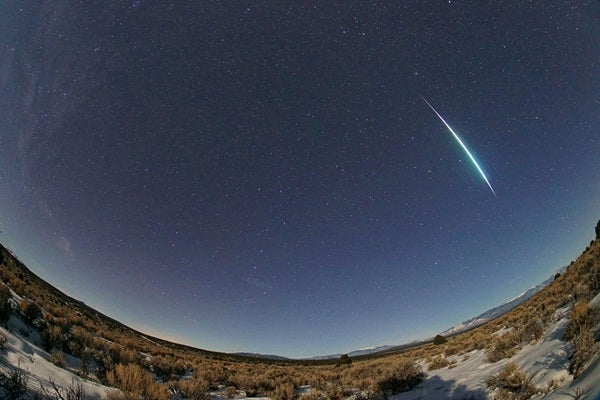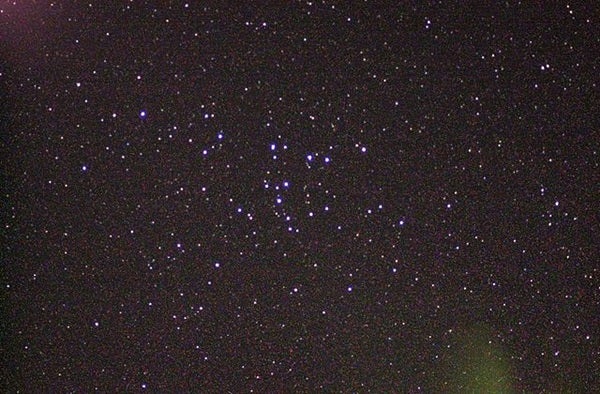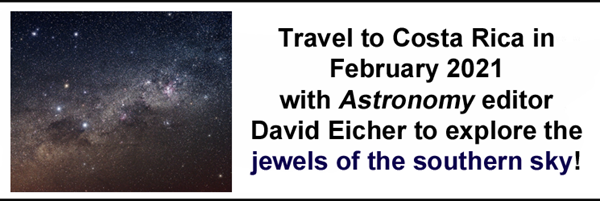For those who celebrate Christmas, there’s a special treat in the southeastern sky for you tonight. In the northwestern part of the constellation Monoceros is the Christmas Tree Cluster, which sits inside the larger NGC 2264 region.
Visible to the naked eye under good conditions, the Christmas Tree really shines in binoculars or a small telescope. You can find the cluster about 11.5° north-northeast of Betelgeuse, the bright red right shoulder of Orion the Hunter, or 5.5° northeast of the Rosette Nebula (NGC 2239).
This triangular cluster of young, hot stars is just a few million years old. The tree touches the famous Cone Nebula at its tip, while the bright magnitude 4.6 star S Monocerotis sits at the base of its trunk. Keep in mind that, depending on the optics you’re using, the tree may appear sideways or upside-down.
For more holiday-themed observing, check out our December 25 entry in last week’s The Sky This Week (December 18 to 25) to explore the extinct constellation Rangifer the celestial reindeer.
Sunrise*: 7:21 A.M.
Sunset: 4:40 P.M.
Moonrise: 1:52 P.M.
Moonset: 3:01 A.M.
Moon Phase: Waxing gibbous (83%)
*Times for sunrise, sunset, moonrise, and moonset are given in local time from 40° N 90° W. The Moon’s illumination is given at 12 P.M. local time from the same location.
By the time the Moon has set this morning (4 A.M. local time), an interesting object has cleared the horizon: the globular cluster M68. Located in Hydra, you’ll find this compact cluster of stars 3.5° below (southeast) magnitude 2.7 Kraz (Beta [β] Corvi).
Glowing around magnitude 8, you can pick up M68 with binoculars or a telescope. Views will improve with time as the object rises, but soon enough you’ll start running into the dawn. M68 is not your average globular cluster. It is extremely old — its stars contain far fewer heavy elements than even most old stars in the Milky Way — and it lies directly opposite our galactic center on the sky. Its orbit is actually carrying it toward us — odd motion for a globular cluster, which should ideally be orbiting the galactic center in a large circle, not headed directly for it. Astronomers believe, based on this and other lines of evidence, that M68 may have originated not in the Milky Way but in another, smaller galaxy that the Milky Way has long since devoured.
Admittedly, M68 is typically best viewed in the spring. But you can still catch it on cold winter mornings like this if the Moon has left the sky and you have a clear view of the southern horizon.
Sunrise: 7:21 A.M.
Sunset: 4:41 P.M.
Moonrise: 2:21 P.M.
Moonset: 4:01 A.M.
Moon Phase: Waxing gibbous (89%)
The Quadrantid meteor shower, which peaks the morning of January 3, will begin ramping up today. Unfortunately, there’s a bright Moon in the sky between now and the shower’s peak; however, given its expected maximum rate of 120 meteors per hour, patient observers still stand a good chance of catching bright shower meteors as the peak approaches. This is particularly true as the Quadrantids often produce bright fireballs — meteors that briefly flare to magnitude –3 or brighter.
The shower’s radiant lies in another extinct constellation — Quadrans Muralis. Today, that sits in the constellation Boötes, home to the familiar bright star Arcturus. The region rises after midnight and stands highest in the eastern sky before dawn, so early mornings for the next several days will be the best time to hunt down shower meteors. This shower is associated with two parent bodies: Comet 96P/Machholz and the minor planet 2003 EH1. Its particles streak through the atmosphere at speeds of 26 miles (42 kilometers) per second — medium fast, as far as meteors go.
Sunrise: 7:21 A.M.
Sunset: 4:42 P.M.
Moonrise: 2:55 P.M.
Moonset: 5:01 A.M.
Moon Phase: Waxing gibbous (95%)
Monday, December 28
A week after their Great Conjunction, Jupiter and Saturn are still sharing close quarters in the sky. They’re less than 1° apart, with magnitude –2 Jupiter just east of magnitude 0.6 Saturn.
Just like last week, you’ll want to start looking for them low in the southwest as soon as twilight begins to darken the sky because they’re both sinking fast. And just like last week, Ganymede is closing in for another transit across Jupiter’s disk — this one doesn’t start until about 10:30 P.M. EST, however, long after the planet has set for those in the continental U.S.
As the gas giants sink below the horizon, look west to see bright Altair in Aquila, now only about 15° high. From Altair, look north-northwest to spot Vega in Lyra; from Vega, gaze east-northeast to find Deneb in Cygnus. These three stars create the familiar Summer Triangle, which gains its name from its position high overhead on summer nights. Now that it’s winter, the Triangle will set earlier and earlier, until its three stars are below the horizon during the cold nighttime hours.
Sunrise: 7:21 A.M.
Sunset: 4:43 P.M.
Moonrise: 3:35 P.M.
Moonset: 6:02 A.M.
Moon Phase: Waxing gibbous (98%)
Tuesday, December 29
Full Moon occurs at 10:28 P.M. EST tonight. Because our bright satellite washes out much of the sky with its glare, consider getting to know some of the terrain on Earth’s closest neighbor instead.
The face of the Moon we see from Earth has several dark splotches visible to the naked eye. These are its maria, or seas, although they were never filled with water. Instead, these dark regions are ancient lava flows. Some of the most easily recognizable are Mare Imbrium and Oceanus Procellarum in the lunar west (the Moon’s left side as you see it in the sky), and Mare Serenitatis, Mare Tranquillitatis, and Mare Fecunditatis in the lunar east (the Moon’s right side in the sky).
Near the bottom of the Moon is a large crater — Tycho — with long, bright rays of material stretching almost halfway up the face of our satellite. These are made of material thrown up during the impact that formed the crater, which traveled great distances in the Moon’s low gravity to ultimately sink down to the ground much farther away.
Sunrise: 7:22 A.M.
Sunset: 4:43 P.M.
Moonrise: 4:21 P.M.
Moonset: 7:01 A.M.
Moon Phase: Full
With a Full Moon still lighting the sky, fainter objects remain hard to find. Instead, search out some of the brighter sky treasures, such as the V-shaped Coma Star Cluster (Melotte 111) in Coma Berenices, which appears above Virgo as they rise in the southeast this morning.
By 4 A.M., the cluster is more than 60° high. One of the easiest ways to find it is to first find Leo the Lion, then draw a line between his brightest star, Regulus, and Zosma, which marks the top of his hindquarters. Follow that line about the same distance off to the northwest and you’ll hit the Coma Star Cluster. This young, loose open cluster contains roughly 100 stars less than 300 light-years away. The members range in magnitude from 5 to 10, so while some are visible to the naked eye under dark conditions, your binoculars or telescope will bring out many more.
Sunrise: 7:22 A.M.
Sunset: 4:44 P.M.
Moonrise: 5:17 P.M.
Moonset: 7:56 A.M.
Moon Phase: Full
Thursday, December 31
Tonight there’s a test for your eyes waiting in the sky. Shortly after dark, Ursa Major is starting to climb her way upward in the sky. By 9 or 10 P.M. local time, her long tail is fully on view; you may recognize this as the kinked handle of the Big Dipper. And right at that kink — the second star from the end — is your challenge. This is the naked-eye binary system Mizar and Alcor. Mizar is magnitude 2, while Alcor is much fainter at magnitude 4. The pair is separated by just 11.8′, with Alcor floating slightly northeast of its brighter companion.
Many people are able to spot both stars under clear, calm conditions. If you’re having trouble, wait a little while to give the stars time to rise higher above the horizon (where the air can be more turbulent). What’s more, Mizar itself is a binary whose components can be split with a small telescope. Sitting 14″ apart, this pair was discovered in 1650. And each of these stars is also a double, although they cannot be visually distinguished.
Sunrise: 7:22 A.M.
Sunset: 4:45 P.M.
Moonrise: 6:18 P.M.
Moonset: 8:46 A.M.
Moon Phase: Waning gibbous (97%)
Friday, January 1
Ring in the new year with Earth’s sister planet, Venus. It rises as a morning star more than an hour before the Sun this morning, but clings low to the southeastern horizon as dawn brightens the sky. The planet is now located 12° east of the famous star Antares, and 2.5° north-northwest of magnitude 3 Theta (θ) Ophiuchi.
Venus is currently on the far side of the Sun from our vantage point, located one and a half times the average Earth-Sun distance from our planet, but only a little over half that distance from the Sun. Its disk appears 94 percent lit and spans 11″.
Scan northeast a bit and you’ll see some familiar sights — Vega and Deneb, two points of the Summer Triangle, are now rising in the predawn sky. Along with Altair, the Triangle’s third point, they will traverse the sky during daytime for the next few months, until our planet’s journey around the Sun brings us back to the summer season.
Sunrise: 7:22 A.M.
Sunset: 4:46 P.M.
Moonrise: 7:24 P.M.
Moonset: 9:30 A.M.
Moon Phase: Waning gibbous (93%)

